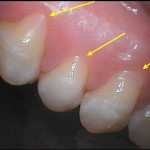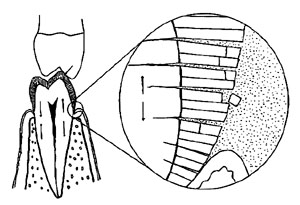Are you suffering from sensitive teeth?
 Tooth sensitivity or known as dentin hypersensitivity is short or transient sharp pain of a rapid onset that arises from exposed dentin layer of one or more teeth subsequent to loss of tooth structure (enamel layer of the crown or cementum layer of the root). It usually occurs in response to stimuli—typically cold, air pressure, drying, sugar, acids, chemicals or forces acting onto the tooth—and cannot be ascribed to any other dental defects or pathology. These stimuli are non-noxious, and are not generally expected to generate a pain response, except as seen in sensitive teeth. In contrast, a noxious stimulus would be the toxins of bacteria within a decay lesion leading to dentinal pain. Areas of exposed dentin at the junction between the crown and the root (cervical area) account for much of the observed tooth sensitivity.
Tooth sensitivity or known as dentin hypersensitivity is short or transient sharp pain of a rapid onset that arises from exposed dentin layer of one or more teeth subsequent to loss of tooth structure (enamel layer of the crown or cementum layer of the root). It usually occurs in response to stimuli—typically cold, air pressure, drying, sugar, acids, chemicals or forces acting onto the tooth—and cannot be ascribed to any other dental defects or pathology. These stimuli are non-noxious, and are not generally expected to generate a pain response, except as seen in sensitive teeth. In contrast, a noxious stimulus would be the toxins of bacteria within a decay lesion leading to dentinal pain. Areas of exposed dentin at the junction between the crown and the root (cervical area) account for much of the observed tooth sensitivity.
Why does exposed dentin cause tooth sensitivity?
The most widely acceptable explanation for sensitive teeth is known as the hydrodynamic theory. The theory suggests that a stimulus causes the fluid within the dentin tubules to flow inward or outward, creating a mechanical disturbance. This excites the nerves in the tooth, thereby transmitting the signal to the pulp where the sensation of pain is registered. Interestingly, and in support of the hydrodynamic theory, it has been demonstrated that various stimuli, including cold, heat, acids, pressure, chemicals, and high osmotic solutions create this movement of fluid within the dentin tubules and individuals with sensitive teeth exhibit open dentin tubules.
Causes of loss of tooth structure
Both enamel and cementum may be lost either gradually or suddenly from the tooth surface. The sudden exposure of dentin will elicit more acute sensitivity since gradual dentin exposure over time allows for the development of protective measures such as smear layer, sclerosis, and proliferation of secondary/ reparative dentin.
Enamel is less susceptible than cementum since it is thicker and more highly mineralized. At the area of the cementoenamel junction there may be only a thin layer of enamel, making this area particularly susceptible to loss of tooth structure. Because the layer of cementum is thin and not highly mineralized, it easily can be abraded or eroded in this area. In approximately 10% of teeth, the enamel and cementum do not meet, leaving an area of exposed dentin. When gum recession is also present, this is a mechanism by which tooth sensitivity occurs.
-
Gum recession
 The occurrence of gum recession is a precursor to the loss of cementum, the exposure of dentin, and the subsequent development of tooth sensitivity. It can occur for a variety of reasons:
The occurrence of gum recession is a precursor to the loss of cementum, the exposure of dentin, and the subsequent development of tooth sensitivity. It can occur for a variety of reasons:
- Anatomically, some teeth may exhibit a narrow zone of attached gingiva. If this narrow zone of attached gingiva is further reduced by recession, little to no gingiva is left to cover and protect the cervical area of the tooth.
- Excessive and abrasive use of any oral hygiene device can lead to gum recession and tooth abrasion, although toothbrush type and the technique used are the primary contributing factors.
- Gum tissue can be lost secondary to periodontal diseases and viral disorders, such as HIV.
- Surgical and nonsurgical periodontal treatment can result in gum recession and root exposure. Other surgical and restorative procedures, such as crown preparations, may also contribute to gum recession and root exposure.
-
Tooth wear
Tooth wear may result from attrition, abrasion or erosion.
Attrition is tooth-to-tooth contact, which results from occlusal function or para-functional habits, such as tooth grinding (bruxism), and can cause loss of tooth structure on the occlusal surfaces and incisal edges.
Abrasion is tooth-to-foreign object contact, most frequently results from incorrect tooth brushing technique which causes gum recession and loss of tooth structure at the cervical areas of the teeth.
Neither abrasion nor attrition usually results in tooth sensitivity due to the force-created smear layer, which occludes dentin tubules. Both of these gradual traumatic processes stimulate the development of natural protective measures, such as secondary dentin and sclerosis. This can be observed in older individuals who show more exposed dentin, but less sensitivity than their younger counterparts.
Erosion is thought to be the major source of tooth wear, and has been defined as tooth dissolution by acids that are not of bacterial origin. Erosion from dietary acids is thought to work in combination with abrasion from tooth brushing and toothpaste, leading to more loss of tooth structure than would be possible with either effect alone. That is why brushing with toothpaste after consuming acidic food or drinks can be damaging. The additive combined effects of abrasion and erosion may not always lead to sensitivity since protective measures may develop over time. Protective measures can be enhanced by the burnishing effects of the toothbrush or toothpick which may stimulate secondary dentin, and the toothpaste abrasives which may serve to obliterate dentinal tubules.
Another mechanism that can lead to loss of tooth structure. An association has been demonstrated between cervical dentin sensitivity and abfractive lesions. These cervical lesions, caused by occlusal stresses, lead to weakening of the cervical tooth structure and can cause enamel, cementum, or dentin to chip away from the cervical aspect of the tooth. The appearance of the lesion is a V-shaped cervical notch. Abfraction is  most likely a co-factor with abrasion or erosion in tooth structure loss, since abfraction has not been identified as a sole cause of sensitive teeth. In fact, enamel loss rarely results from a single agent but rather from a combination of two or three contributing factors.
most likely a co-factor with abrasion or erosion in tooth structure loss, since abfraction has not been identified as a sole cause of sensitive teeth. In fact, enamel loss rarely results from a single agent but rather from a combination of two or three contributing factors.
Since it may be difficult to differentiate between dentin sensitivity and a variety of other tooth and/or pulp-associated reasons for discomfort, we often have a difficult time describing the pain and may not be able to localize it to any specific tooth or teeth, although they are usually more accurate in localizing sensitivity than dentinal or pulpal pain. A differential diagnosis to rule out other conditions must be established before resorting to treatment as these require totally different treatment approaches.

Both enamel and cementum may be lost either gradually or suddenly from the tooth surface. The sudden exposure of dentin will elicit more acute sensitivity since gradual dentin exposure over time allows for the development of protective measures such as smear layer, sclerosis, and proliferation of secondary/ reparative dentin.
thank admin